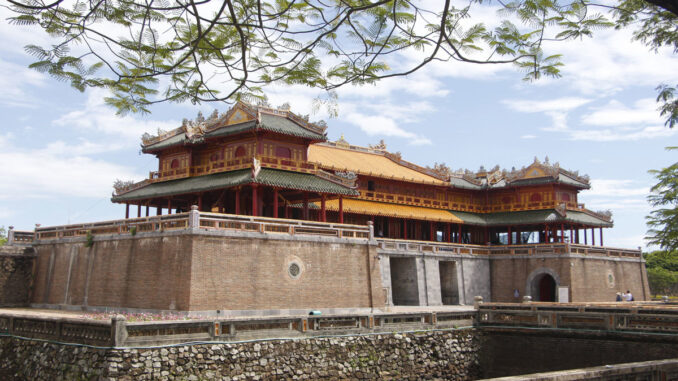
Tourist icons and famous landmarks such as Ninh Binh, Ha Long Bay, Hue, and Khue Van Cac… are printed in the new passport to promote the image of Vietnam.

The new ordinary passport form will be applied from July 1. Accordingly, the green cover is changed to blue-violet. The procedures for issuance and exchange remain the same as for the old passport.

The passport remains the same size, 8.8 cm wide, 12.5 cm long and about 0.75 cm thick. The inner pages of the new passport also have some changes.

The biggest change is that each page has landscape images that are tourism icons of Vietnam. Famous cultural heritages, images of national sovereignty appearing in passports are: Ha Long Bay, Hue Imperial City, Hung Temple, Hoi An Ancient Town, My Son Sanctuary, Nha Rong Wharf, Lung Flagpole Cu, Temple of Literature – Quoc Tu Giam… This innovation contributes to promoting Vietnam’s image to the world and expressing the country’s historical and cultural traditions.
Pictured is Trang An , Ninh Binh, a world cultural and natural heritage recognized by UNESCO. This is also the first mixed heritage of Vietnam and Southeast Asia.
>> See more Ninh Binh travel guide

Each site occupies two sides of the page. Pictured is Khue Van Cac , located in the Temple of Literature – Quoc Tu Giam, Hanoi. This is a small building but has a unique architecture with the sound of the Nguyen Dynasty. Khue Van Cac is the symbol of Hanoi capital, appearing on the street names of the inner city.
>> See more Hanoi travel guide

Ha Long Bay, Quang Ninh is the next place to appear in the new passport. This place has more than 1,600 large and small limestone islands with all shapes scattered, creating a magnificent scene. The bay has twice been recognized by UNESCO as a World Natural Heritage for aesthetic value (1994) and geological and geomorphological value (2010). Photo: Shutterstock/Andy Tran
>> See more Ha Long travel guide

Hue Citadel is one of the relics belonging to the Complex of Hue Monuments Complex recognized by UNESCO as a World Cultural Heritage. This is also known as the ancient capital because it used to be the capital of Vietnam under the Nguyen Dynasty from 1805 to 1945. The citadel was built on an area of more than 500 hectares in three rounds in the order of the Imperial Citadel, the Imperial Citadel and the Forbidden Forbidden City. Wall. King Gia Long built the citadel from 1805, only completed in 1832 under King Minh Mang. Photo: Vo Thanh
>> See more Hue travel guide

Hung Temple in Phu Tho is the place where all Vietnamese people look forward to each anniversary of the ancestors. Temple of Hung King, who had merit to build the country. This is an important historical and cultural relic of the country, located on Nghia Linh mountain with an altitude of 175 m above sea level, belonging to Phong Chau land of Van Lang State 4,000 years ago. Photo: Trung Nghia
>> See more Phu Tho travel guide

Hoi An ancient town , Quang Nam cannot be absent in the new passport. Hoi An attracts domestic and foreign tourists by keeping its nostalgic features with ancient houses, tiled roofs, painted in saffron color, next to Hoai River shimmering every night when people release lanterns together. Hoi An was recognized by UNESCO as a World Cultural Heritage in 1999. Photo: Phan Cong Nguyen
>> See more Hoi An travel guide

Lung Cu flagpole , Ha Giang is the northernmost symbol of Vietnam, with a flag 9 m high. The image of the flagpole also appears on page 9 of the new passport. This place has an altitude of about 1,470 m above sea level, in Lung Cu commune, Dong Van district. The column is about 3.3 km from the North Pole. This place was built according to the model of the Hanoi flag pole but smaller in size. Photo: Jimmy Tran/Shutterstock
>> See more Ha Giang travel guide

The tourist symbol that cannot be ignored when coming to Ly Son, Quang Ngai is To Vo Gate in the east of the island. This is a stone gate, more than 2 m high, right next to the sea. People believe that the lava that erupted from the volcano 2 million years ago was frozen when it met sea water, forming the arch with this special shape. Surrounded by black lava rock. The best time to go to To Vo gate is at sunset, when the sun gradually disappears behind the horizon and the sun’s rays glimmer through the rocky crevices. Photo: Trung Nghia
>> See more Ly Son travel guide

My Son Sanctuary in Quang Nam Province has been a World Cultural Heritage Site since 1999. The site is 70 km from Da Nang and 40 km from Hoi An. This is the Hindu holy place of the ancient Champa Kingdom. The structure of each cluster consists of the main temple, surrounded by a small tower. In which, the main temple represents Mount Meru, the center of the universe, the gathering place of gods and worshiping Siva. Photo: Tuan Dao

Fansipan peak in Lao Cai, about 9 km from Sa Pa town, appears on passports with a landmark image, showing the majesty of the roof of Indochina. The peak is 3,147 m high, is the destination of many mountaineers and cloud hunters. If you can’t afford to climb on your own, you can take the cable car up to the place. Photo: To Ba Hieu, Le Viet Khanh
Follow (vnexpress)
